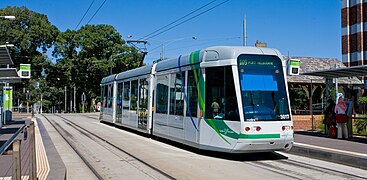Wikijunior:Public Transit/Tram
If you'd never seen a tram (also known as a streetcar) before, it would seem very weird, even surreal. Is it a train, running on a street? Or is it a bus that runs on rails?
In fact, it's both, and that's why trams are so useful: they combine the benefits of trains and buses. Trams are like small, very light trains that run on tracks in the street. They draw power from wires above. But they also stop just as often as buses, run efficiently, and help reduce the number of cars on the road by packing more people in. Unlike commuter trains or subways, they don't need special buildings or stations: just a sign and maybe a shelter, just like buses.
In the world of trams, Melbourne is definitely the king. It has the world's largest tram network, with more than 500 individual trams and 24 routes.
-
There are many different models of tram in operation in Melbourne. This is a "B-class".
-
This is a "Z-class". They are an older design, and less than one hundred are still used.
-
These newer "C-class" trams were first introduced in 2002.
-
Fancy new "E-class" trams like this one were first used in 2013.
-
Sometimes trams get stuck in traffic. Which model is this one?
Toronto has a large tram system, although most of the routes focus on the downtown area. The width between each rail is called the gauge (pronounced "gadje"), and Toronto uses a uniquely wide gauge not used anywhere else, so trams have to be specially designed to run there. The Toronto gauge is 1495 mm – for comparison, the gauge used for Melbourne's streetcars is 1435 mm, a standard width. Toronto is Canada's largest city, and an average of about 241,000 people ride these streetcars every day. The Toronto streetcar network has 82 kilometers of rails.

{{{8}}}
edit{{{9}}}
{{{11}}}
edit{{{12}}}





